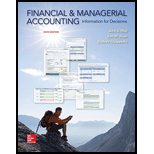
Financial and Managerial Accounting: Information for Decisions
6th Edition
ISBN: 9780078025761
Author: John J Wild, Ken Shaw Accounting Professor, Barbara Chiappetta Fundamental Accounting Principles
Publisher: McGraw-Hill Education
expand_more
expand_more
format_list_bulleted
Concept explainers
Textbook Question
Chapter 3, Problem 24QS
Classifying
The following are common categories on a classified balance sheet.
- Current assets
- Long-term investments
- Plant assets
- Intangible assets
- Current liabilities
- Long-term liabilities
For each of the following items, select the letter that identifies the balance sheet category where the item typically would best appear.
_____ 1. Land not currently used in operations
_____ 2. Notes payable (due in five years)
_____ 3.
_____ 4. Trademarks
_____ 5. Accounts payable
_____ 6. Store equipment
_____ 7. Wages payable
_____ 8. Cash
Expert Solution & Answer
Want to see the full answer?
Check out a sample textbook solution
Students have asked these similar questions
Solve this question and accounting question
General accounting
I need help with this solution and accounting question
Chapter 3 Solutions
Financial and Managerial Accounting: Information for Decisions
Ch. 3 - Prob. 1MCQCh. 3 - Prior to recording adjusting entries, the Supplies...Ch. 3 - Prob. 3MCQCh. 3 - Prob. 4MCQCh. 3 - If a company had $ 15,000 in net income for the...Ch. 3 - What is the difference between the cash basis and...Ch. 3 - Why is the accrual basis of accounting generally...Ch. 3 - What type of business is most likely to select a...Ch. 3 - Prob. 4DQCh. 3 - Prob. 5DQ
Ch. 3 - Prob. 6DQCh. 3 - Prob. 7DQCh. 3 - Prob. 8DQCh. 3 - A If a company initially records prepaid expenses...Ch. 3 - Prob. 10DQCh. 3 - Prob. 11DQCh. 3 - Prob. 12DQCh. 3 - Prob. 13DQCh. 3 - Prob. 14DQCh. 3 - Prob. 15DQCh. 3 - Prob. 16DQCh. 3 - Prob. 17DQCh. 3 - Prob. 18DQCh. 3 - Prob. 19DQCh. 3 - Prob. 20DQCh. 3 - Prob. 21DQCh. 3 - Prob. 22DQCh. 3 - Prob. 23DQCh. 3 - Prob. 24DQCh. 3 - Prob. 25DQCh. 3 - Prob. 26DQCh. 3 - Prob. 27DQCh. 3 - Prob. 28DQCh. 3 - Prob. 29DQCh. 3 - Periodic reporting C1 Choose from the following...Ch. 3 - Computing accrual and cash income C1 In its first...Ch. 3 - Identifying accounting adjustments P1 Classify the...Ch. 3 - Prob. 4QSCh. 3 - Prepaid (deferred) expenses adjustments P1 For...Ch. 3 - Prepaid (deferred) expense adjustments P1 For each...Ch. 3 - Prob. 7QSCh. 3 - Prob. 8QSCh. 3 - Prob. 9QSCh. 3 - Prob. 10QSCh. 3 - Prob. 11QSCh. 3 - Prob. 12QSCh. 3 - Prob. 13QSCh. 3 - Prob. 14QSCh. 3 - Recording and analyzing adjusting entries P1...Ch. 3 - Prob. 16QSCh. 3 - Prob. 17QSCh. 3 - Prob. 18QSCh. 3 - Prob. 19QSCh. 3 - A preparing adjusting entries P4 Cal Consulting...Ch. 3 - Preparing closing entries from the ledger P4 The...Ch. 3 - Identifying post-closing accounts P5 Identify...Ch. 3 - identifying the accounting cycle C2 List the...Ch. 3 - Classifying balance sheet items C3 The following...Ch. 3 - Identifying current accounts and computing the...Ch. 3 - Prob. 26QSCh. 3 - Prob. 27QSCh. 3 - Prob. 1ECh. 3 - Exercise 3-2 Adjusting and paying accrued expenses...Ch. 3 - Prob. 3ECh. 3 - Prob. 4ECh. 3 - Prob. 5ECh. 3 - Prob. 6ECh. 3 - Prob. 7ECh. 3 - Prob. 8ECh. 3 - Prob. 9ECh. 3 - Prob. 10ECh. 3 - Prob. 11ECh. 3 - Prob. 12ECh. 3 - Prob. 13ECh. 3 - Prob. 14ECh. 3 - Prob. 15ECh. 3 - Prob. 1PSACh. 3 - Prob. 2PSACh. 3 - Prob. 3PSACh. 3 - Prob. 4PSACh. 3 - Prob. 5PSACh. 3 - Prob. 6PSACh. 3 - Prob. 7PSACh. 3 - Prob. 8PSACh. 3 - Prob. 1PSBCh. 3 - Prob. 2PSBCh. 3 - Prob. 3PSBCh. 3 - Prob. 4PSBCh. 3 - Prob. 5PSBCh. 3 - Prob. 6PSBCh. 3 - Prob. 7PSBCh. 3 - Prob. 8PSBCh. 3 - Prob. 3SPCh. 3 - Prob. 1GLPCh. 3 - Prob. 2GLPCh. 3 - Prob. 3GLPCh. 3 - Prob. 4GLPCh. 3 - Prob. 5GLPCh. 3 - Prob. 6GLPCh. 3 - Prob. 1BTNCh. 3 - Prob. 2BTNCh. 3 - Prob. 3BTNCh. 3 - Prob. 4BTNCh. 3 - Prob. 5BTNCh. 3 - Prob. 6BTNCh. 3 - Prob. 7BTNCh. 3 - Prob. 8BTNCh. 3 - Prob. 9BTN
Knowledge Booster
Learn more about
Need a deep-dive on the concept behind this application? Look no further. Learn more about this topic, accounting and related others by exploring similar questions and additional content below.Similar questions
- I want the correct answer with accountingarrow_forwardI want the correct answer with accounting questionarrow_forwardOriole Company sells product 2005WSC for $55 per unit and uses the LIFO method. The cost of one unit of 2005WSC is $52, and the replacement cost is $51. The estimated cost to dispose of a unit is $6, and the normal profit is 40% of selling price. At what amount per unit should product 2005WSC be reported, applying lower-of-cost-or-market?arrow_forward
arrow_back_ios
SEE MORE QUESTIONS
arrow_forward_ios
Recommended textbooks for you
 Cornerstones of Financial AccountingAccountingISBN:9781337690881Author:Jay Rich, Jeff JonesPublisher:Cengage Learning
Cornerstones of Financial AccountingAccountingISBN:9781337690881Author:Jay Rich, Jeff JonesPublisher:Cengage Learning Managerial AccountingAccountingISBN:9781337912020Author:Carl Warren, Ph.d. Cma William B. TaylerPublisher:South-Western College Pub
Managerial AccountingAccountingISBN:9781337912020Author:Carl Warren, Ph.d. Cma William B. TaylerPublisher:South-Western College Pub Financial And Managerial AccountingAccountingISBN:9781337902663Author:WARREN, Carl S.Publisher:Cengage Learning,
Financial And Managerial AccountingAccountingISBN:9781337902663Author:WARREN, Carl S.Publisher:Cengage Learning, Financial Accounting: The Impact on Decision Make...AccountingISBN:9781305654174Author:Gary A. Porter, Curtis L. NortonPublisher:Cengage Learning
Financial Accounting: The Impact on Decision Make...AccountingISBN:9781305654174Author:Gary A. Porter, Curtis L. NortonPublisher:Cengage Learning Survey of Accounting (Accounting I)AccountingISBN:9781305961883Author:Carl WarrenPublisher:Cengage Learning
Survey of Accounting (Accounting I)AccountingISBN:9781305961883Author:Carl WarrenPublisher:Cengage Learning


Cornerstones of Financial Accounting
Accounting
ISBN:9781337690881
Author:Jay Rich, Jeff Jones
Publisher:Cengage Learning

Managerial Accounting
Accounting
ISBN:9781337912020
Author:Carl Warren, Ph.d. Cma William B. Tayler
Publisher:South-Western College Pub

Financial And Managerial Accounting
Accounting
ISBN:9781337902663
Author:WARREN, Carl S.
Publisher:Cengage Learning,

Financial Accounting: The Impact on Decision Make...
Accounting
ISBN:9781305654174
Author:Gary A. Porter, Curtis L. Norton
Publisher:Cengage Learning

Survey of Accounting (Accounting I)
Accounting
ISBN:9781305961883
Author:Carl Warren
Publisher:Cengage Learning
The ACCOUNTING EQUATION For BEGINNERS; Author: Accounting Stuff;https://www.youtube.com/watch?v=56xscQ4viWE;License: Standard Youtube License